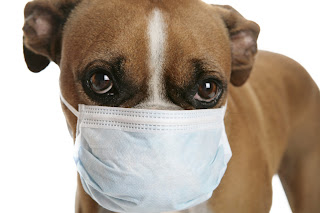With the July 4th celebrations upon us, it’s time
to have the ever popular talk about loud noises, and what it means for your
dog. About one third of dog owners report their fuzzy friends have what we in
the ‘biz’ call “noise aversion”... or a fear of loud noises. These loud noises
could be in the form of thunder, loud cars, construction, or at this time of
year, fireworks. Dogs relay their fear
of noise in a variety of behavioral ways including panting, trembling,
drooling, cowering, and escape behavior. Escape behavior is particularly
dangerous to your canine companion if you happen to be out of your home or in a
public place when the event strikes. Here’s a refresher course on how to keep
your furry friends safe at this potentially stressful time of year:
Be ahead of the game: Anticipate events
and weather (as best you can in these parts) and anything else that can be a
potential stressor for your pooch and set him up to win. This may be making
sure he’s in a safe place in the morning if you know there will be storms later
in the day, medicating him, or making sure you’re able to be with him at the
time of the event.
Plan
for the best; prepare for the worst: We all know that even with the most
meticulous planning, things can still go wrong. There are a couple ways to be
prepared; one is making sure you know where your local emergency clinics are in
case something goes wrong outside of your regular veterinarian’s business
hours. Another simple method is making sure your pet has proper identification
in the event of an escape. Many larger pet supply stores can hook you up with a
personalized tag in a matter of minutes. Alternatively you can have your pet
microchipped, and their ID can travel along with them forever. Microchipping is
a quick procedure that can be done by your vet, typically without sedation.
Know their limits: As much as you may wish you had the kind of dog
that could peacefully sit through a fireworks finale, or won’t wake you up at 3
am because a storm is coming, not everyone is that lucky. A dog’s tolerance to
stressful events can often run on a sliding scale of positive and negative
reinforcements. Meaning, if your dog already stresses out at certain events,
forcing him to do them are not the way to get him accustomed to them, it’ll
just make it a more stressful event. Talk to your vet or a trainer about steps
you can take to help your furry friend work through his fears. Bonus points:
training can help you bond with your pooch.
Know when to ask for help: There are
many products on the market that claim to help with your pet’s stress level.
Though you can spend the time and effort to sift through the product claims, remember
that it’s our job to do that; let us help! You may have already heard of the
newest product we’re carrying to help pets with their noise related stresses;
Sileo. In a nutshell, it’s a product that can be administered to your pet at
the time of the stressful event. Feel free to call us and ask what the best
course of action is to help your pet with their stresses.
Having
a reactive pet can be a little stressful to YOU as well. As with any issue you
may face on the long and windy road of pet ownership, remember that we here in
the vet care industry want nothing more than to help you keep your pet safe and
healthy. Though it’s been said, many times, many ways, keep your pets safe this
Independence Day.


